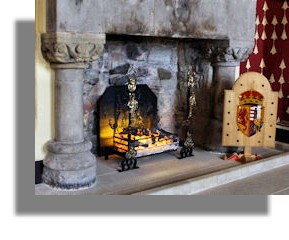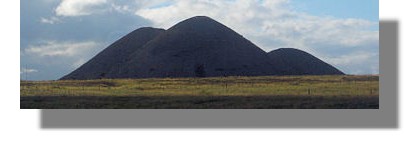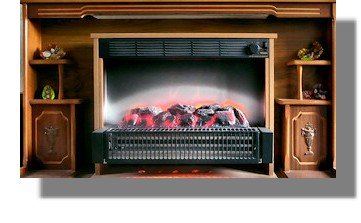Scottish Memory Lane - Coal Fires
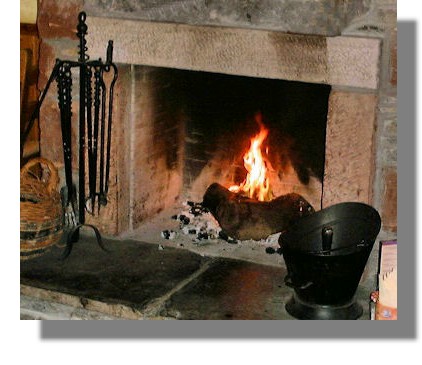
Coal Fire in a House in Luss, Scotland
Fires to provide heating inside houses goes back a long way but it is really only since the 16th and 17th centuries that houses other than castles and large mansion houses have had fireplaces and chimneys to take away the resulting smoke. Initially fires used wood as fuel but coal burning expanded rapidly since the Industrial Revolution, which began in Britain in the 18th century, and later spread to continental Europe and North America. But by the end of the 20th century most homes had changed to "central heating" of various types and coal fires had rapidly declined. But there is still a nostalgia for its flickering flames forming the centre of a home and family life. But the reality was often not as attractive as we sometimes think!
Keep the Home Fires Burning
Initially, of course, fires inside buildings to create warmth were confined to places like palaces, castles and (later) large mansion houses. The graphic on the right shows a fireplace in Stirling Castle, a Royal Palace frequented by Mary Queen of Scots and King James VI of Scotland (until he went off to the bright lights of London in 1603). And these fires mainly burnt logs and wood.
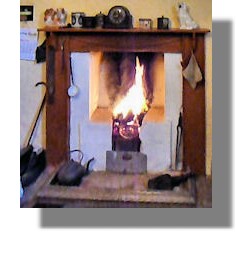
It was not until the Industrial revolution when steam power produced from burning coal also created a ready source of material for domestic use. Houses soon had chimneys attached to them to take away the smoke and fumes and even small cottages had their own coal fires (or peat in some parts of Scotland)
It was a great advance having a source of heat and with the smoke going up a chimney. The original "black houses" in the north of Scotland where the fire was in the middle of the main living area and the smoke - or at least some of it - vented through a hole in the roof. But we mustn't forget that every morning the ashes from the previous day had to be shovelled out of the hearth and a new fire lit. There was a fine art eventually in crumpling up old newspapers, laying small sticks on top and a few small lumps of coal and (hopefully) setting it all ablaze. Eventually, "fire lighters" impregnated with combustible material took over from simple firewood sticks. It was often the wives who were up early to get the main fire in the living room going. In many city tenements (tall apartment blocks) the only room with a fire was the main living area. Such morning rituals continued for many till the second half of the 20th century.
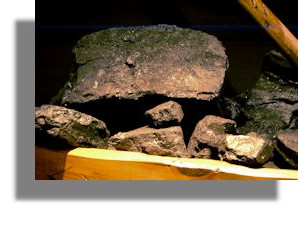
Coal Delivery
Getting the coal from underground coal mines was just the start of the process of getting the coal into the living room fires. In 1913, the peak year of coal production, the Scottish mining industry employed over 140,000 men and women, who with their families, made up ten percent of the Scottish population.
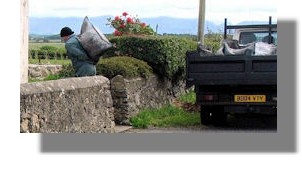
In the first half of the twentieth century the coal delivery vehicles were a frequent sight in the streets of towns. Initially horse drawn and later motorised, there were loud shouts of "COAL!!" from the delivery men and householders would buy whatever quantity they needed (or could afford). But the last step in the process was getting the bags of coal (each weighing a hundredweight or 112 pounds) from the street to the coal "bunker" which was either in the house or outside if there was a garden. The delivery men carried the sacks on their backs and the houses on the top floor could be up five flights of stairs. The graphic here of a delivery lorry and a coalman carrying a bag of coal is by Eric Jones via Wikimedia Commons).
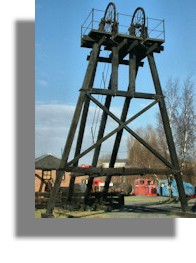
There are only a few mines still operating in Scotland now and most of the familiar pit head winding towers have all but disappeared (the one shown on the right is part of the Summerlee museum of Scottish industrial life). But one visible legacy of all that effort that can be seen in Scotland are the "coal bings" where the coal mines dumped the unwanted earth and spoil from the mine tunnelling creating mini mountains on the landscape. Efforts have been made to remove them but a good number are still very visible - as in the picture below of coal bings near Fauldhouse in West Lothian by Paul Birrell via Wikimedia Commons)
Chimney Sweeps
Of course, coal fires created a lot of soot (which particularly in certain weather conditions in cities created "smog" - a word created from merging the words smoke and fog - and the unpleasant and dangerous components were sometimes referred to as a "pea souper".
But most of the soot particles actually accumulated in the chimneys as creosote and if these were not removed, the soot could not escape to the sky as intended - and there was even a danger of the creosote catching fire . So an army of chimney sweeps would go round houses removing the soot. This involved first of all blocking the fireplace so that as far as possible, the soot didn't get into the rooms and lowering brushes from the top of the chimney that swept the soot down to the foot. If all went well, the sweep could then remove the soot without too much escaping into the house.
Some larger houses and others that were badly designed didn't respond to the brushes and in the UK and some other countries young children would be sent down the chimney to do the cleaning by hand. They were technically called chimney sweeps "apprentices"
Oddly, in Britain it is considered lucky for a bride to see a chimney sweep on her wedding day and British sweeps would cash in on this by hiring themselves out to attend weddings. The "lucky" reputation of British chimney sweeps was shown to good effect in the "Mary Poppins" film when Dick van Dyke, sings "Chim Chim Cher-ee" (which won the Oscar for "Best Song" in 1965). The chorus refers to the traditional association of chimney sweeps with good luck - "Good luck will rub off when I shake 'ands with you, or blow me a kiss ... and that's lucky too"...
In the second half of the 20th century "smokeless" fuels and centra heating, combined with Clean Air Acts in the UK saw the demise of coal fires in homes. This was accelerated in the aftermath of the "Great London Smog" of 1952 which saw the estmated premature deaths of between 4,000 and 12,000 people as a direct result of air pollution.
Modern "Coal Effect" Fires
Despite all the benefits of central heating (especially in a climate such as we have in Scotland where there is certainly no demand for air conditioning to cool us down even in the summer) there is still a nostalgia, among the older generation in particular, about a coal fire. Especially in country areas, restaurants and bars will often make a selling point of having a "real" fire.There is also a demand for "coal effect" fires in the UK (a quick glance at Amazon UK's pages for these products suggests there is a roaring trade for these in many different designs). Many are electric fires with the usual heating bars but with a "coal effect" created by a plastic moulding. The impression of flames is created by an orange bulb with a small propeller above which rotates due to the heat of the bulb, producing a kind of "flickering flame".
Return to Index of Memory Lane.
